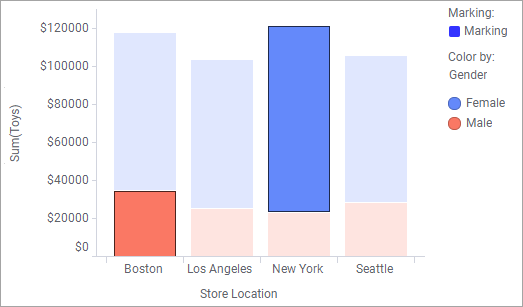Marking
The action of marking visualization items means selecting parts of the data that you find of certain interest to examine in more detail, or to work at in various ways. To gather the marked items, and to recognize them as marked, they are associated with a certain marking.

You mark items in different ways, for example by clicking them. Example of items are bar segments, markers, lines, and pie sectors. Items that have been marked are easily distinguished: the unmarked items' colors fade out, but the marked items keep their original colors and get a dark outline as shown above.
When you mark items in a visualization, you in fact mark the corresponding rows in the data table. To identify and represent this entire set of marked rows, a special concept is used, marking. A marking is assigned two attributes, a name and a color, and can be viewed in the legend, see the image above.
Because rows in the data table become marked, every visualization in your analysis that uses the data table and the same marking is affected. If items in other visualizations include any of the marked data rows, they become marked too.
- Marking items
You can mark items in a visualization to view details for the items or to clarify connections between visualizations. Marking, for example, a pie sector or a bar is equivalent to marking all the data rows that are included in that pie sector or bar. - Marking items using the legend
You can mark items of a certain category using the legend in a visualization. - Unmarking items
There are several ways to unmark a previously marked item. - Reapplying markings when reloading data
When you are working with data that is linked to the source, you might need to consider what happens to your markings when the data is reloaded. - Exploring data across visualizations
In an analysis, marking items in one visualization spreads to other visualizations based on the same data table. This way you can explore the same data in different contexts.